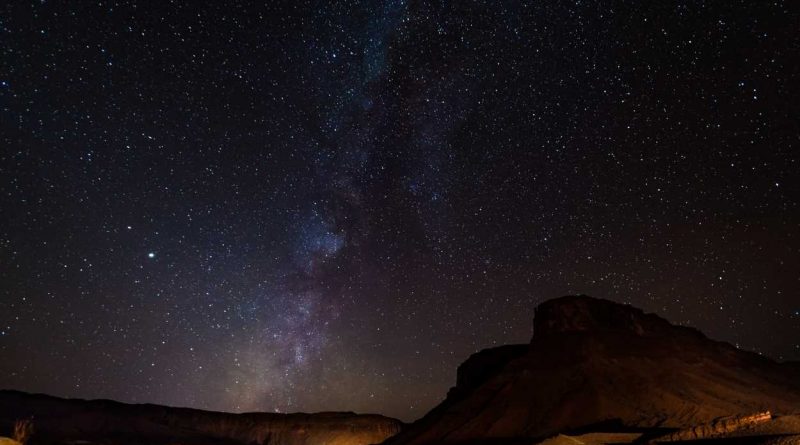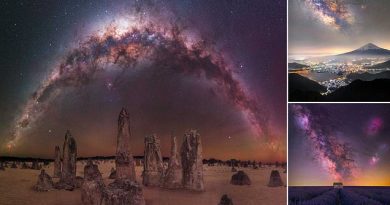A Stargazing Road Trip Across the American Southwest
All listings featured on Condé Nast Traveler are independently selected by our editors. If you book something through our links, we may earn an affiliate commission.
The forecast was not promising. The sweeping New Mexican skies appeared clear, and ribbons of cerulean, violet, and indigo created an ombré horizon as the sun receded behind the West Mesa and the Rio Grande. But the clouds would soon roll in. Outside the main house at Los Poblanos, a historic farm and inn on the edge of Albuquerque, an orange tabby curled up on a bench, an outdoor firepit was lit, a bottle of wine opened. There would be no stargazing this evening. It hadn’t occurred to me that my entire quest—to trek across the high desert of the Southwest and into the mountains of Utah—could be thwarted by something as evanescent as the clouds. I flicked around an atmosphere-predicting app on my phone to see what the following evening might bring. Again, it augured obscurity.
Originally my partner, Tony, and I had planned to drive out to Salinas Pueblo Missions National Monument, a complex of ruins left behind by 17th-century Spanish Franciscan missionaries and Puebloans, to see the sunset and drive back beneath a blanket of stars. But with the outlook hazy, we settled for an outdoor dinner overlooking the farm’s freshly shorn lavender fields. Throughout the night, despite my attempts to sneak up on a star or two by flinging open the door of our ranch room at odd hours, not one pinprick of light emerged. Nor did any the next evening, as I sat by the fire at Santa Fe’s cozy Inn of Five Graces. While the distant sounds of honking horns told the day’s news of a presidential election decided, I alternately peered out at a slurry of freezing rain and held my phone skyward, its screen locating where Sagittarius, Cassiopeia, Orion, and Pisces might be were they not hidden by a thick, wet mist.
There are few activities more democratic and astonishing than looking up into a night sky, even when ensconced in the murky depths of urbanity. Last night, while standing in my New Orleans kitchen stirring a pot of beans, I caught sight of the full moon through the steam of my loft’s old factory window—there it was, humongous and golden, hanging over the Mississippi River—and my breath caught in my throat. Of course, though, it’s the moments in the middle of nowhere, with an unmitigated view of the Milky Way as it trickles both familiarly and positively strangely across the pitch-black canvas of the universe beyond, when we find ourselves most vulnerable to childlike states of pure incomprehension.
Utter wonder. This is the feeling I was looking for—one I think many of us are looking for these days—when I planned a road trip based entirely on seeing the darkest skies I could find, an increasingly rare phenomenon in an age shackled to the glow of artificial light. I started by mapping a route with the help of the International Dark-Sky Association (IDA), an organization that bills itself as the authority on light pollution and has certified and protected nearly 38,610 square miles around the globe as dark-sky places. In the United States, the densest concentration of IDA-certified locations is found across the states that meet at the Four Corners—New Mexico, Arizona, Utah, and Colorado. Wanting to experience a range of topography, my options were rather narrowed by imminent winter weather (i.e., no camping) as well as COVID-19 closures, so I settled on a trail from New Mexico through the corner of Arizona and an arc through Utah. After my cloud-stricken swoop through Albuquerque (home to a very active astronomy association) and Santa Fe, I found a rare vacancy at Shash Diné, an off-grid bed-and-breakfast in the northeast tip of the Navajo Nation in Arizona.
Astrotourism, though a relatively new concept with a nascent infrastructure, is a growing category of travel that’s encouraged by national and state parks programming, as well as by advocacy on the part of local stargazing enthusiasts. But no one in this country has a deeper connection or history with the night skies than Indigenous peoples. Shash Diné was built by Baya and Paul Meehan on land Baya’s family has stewarded for at least 20 generations. The name, which translates to “bear people,” is an homage to Baya’s Navajo clan. Though legally she owns no part of the land Shash Diné occupies, it is inextricable from her innermost self. “This is me,” she said by way of introducing us to her home.
Shortly after we arrived at Shash Diné, the wind picked up and the temperature plummeted. But our modern steel cube (dubbed the Kyōōb) overlooking the vast grazing lands northeast of the Grand Canyon was deeply warm, heated by a wood-burning stove and outfitted with a pile of thick blankets. Three platforms with beautifully decorated tents and two restored pioneer-era covered wagons are also available for stays in the warmer months.
Before sundown, Baya invited us into a massive hogan, a mud-covered structure with a skylight in the center, where we sat on opposite sides, drinking from an enamel pot full of Navajo tea made of roasted greenthread. A fire puffed from a stove, and the walls, a woven mass of pale, gnarled juniper branches, silenced the approaching storm’s bluster. Baya told us that her grandparents were the last generation to live the traditional way, migrating seasonally with their Churro sheep up the Kaibito Plateau and down to the valley, or in the shorthand of Baya’s family, “upstairs” and “downstairs.” For a time she left the Navajo Nation to travel and work, staying with friends. When she met Paul, she felt a calling to return home and sought the approval of her family’s matriarchs to create this place.
By sunset the snow had started to fall sideways, and Tony and I climbed into our fire-lit cabin to watch the storm blow in. But just before it did, miraculously, the sky beyond the cube’s wall of windows cleared. We piled on layers, tiptoed out onto the snow-dusted prairie, and sucked in our breath as a planetarium opened up before us. Mars and then Saturn and then Jupiter winked through the clouds along with a hundred thousand stars. The absurdity of “owning” land becomes immediately apparent when you begin to consider the heavens above. And as quickly as the sky opened, it closed once again.
Whereas languages die, paintings fade, buildings fall, and entire cities crumble, the visible celestial plane exists almost exactly as it did when the dinosaurs were munching on treetops and one another. Of course, satellites, rovers, and space junk endanger the constellations, seemingly mimicking their glimmer until you stare long enough to realize they are but unfixed nomads. And even with these blemishes, the night skies continue to dazzle; it’s no wonder every civilization since the dawn of time has braided its origin within the stars, or that we continue to look to them to tell our fortunes.
The following evening, just over the Utah border from Shash Diné, Eli Secody, a Navajo storyteller, unraveled the wisdom of the Só Dine’é, or “star people,” as his kin refer to the constellations. “These are winter stories,” said Secody from across a fire at Camp Sarika, a new part of the Amangiri hotel complex. “Now that the second snow has fallen, we can tell these stories.”
Finally, the stars emerged and the Milky Way blazed over the frostbitten earth. As Secody tells it, Folding Darkness Boy (who is responsible for rejuvenation and healing during sleep) is the first to appear in the blue light after sunset. Next comes First Man Náhookos Bi’ka (the Big Dipper) and First Woman Náhookos Bi’áád (Cassiopeia), who are connected by a fireplace, Náhookos Bikó (the North Star). Finally, Folding Darkness Girl shows up just before dawn to wake sleepers. But the star people are more than shapes loosely drawn around one another. The Navajo relationship with the skies is highly spiritual, and as Secody explains, each constellation contains within it not only lessons of guidance and the power to heal, but also a piece of the universe and the entirety of the universe itself. It would take nights upon nights to trace the interconnected web of the stars and the Navajo. Secody ended by singing another winter story, his voice carried across the canyon by the breeze.
Several hours north at Kodachrome Basin, near the Grand Staircase-Escalante National Monument, surrounded by sienna sandstone spires, park ranger Nathan Martinez unloaded a massive telescope from his truck bed along with a canteen of hot water, envelopes of Swiss Miss, and a can of Reddi-wip. The sun descended, making a creepy chiaroscuro of the topography as the soft-spoken, red-bearded ranger plugged in the coordinates of Saturn and we waited for darkness to come. When it did, he gestured for me to look through the lens. With one eye squeezed shut and the other wide-open, I pressed my face to the eyepiece. What looked like a glow-in-the-dark sticker I might have applied to the ceiling of my childhood bedroom—tipped on its side, rings and all—was an actual planet, 746 million miles away, its icy aura spinning in perpetuity. A few minutes later, a star shot through the Hercules Globule, the Pleiades blinked on, and we all stared into our neighboring galaxy Andromeda, pondering the fact that one day it will collide with the Milky Way, destroying and rearranging absolutely everything.
A pointed stargazing trip necessitates constantly looking forward to nightfall, but the early winter days driving through Utah were majestic. Martinez, who spends his time off work hiking and camping across the state, suggested that on our way to Moab we cut across Route 12 through the Escalante Monument, which comprises more than 1.8 million acres of nationally protected 200-million-year-old staircase formations. Some sections look like psychedelic martian territory: stacks of melting sediment frozen in time, sandstone arches worn to slender bracelets against the vast blue sky. Several tiny, picturesque towns dot the landscape, including Escalante, where Yonder Escalante, a new hotel with cabins, Airstreams, and R.V. hookups, was recently built on the site of an old drive-in movie theater.
Just outside of Moab, Sorrel River Ranch is an excellent jumping-off point for Arches National Park, where camping is available year-round and stargazers can enter anytime—a rarity, especially in the off-season. That evening, after a sunset horseback ride through muddy gulches and over watercolored bluffs with Sorrel’s wrangler Diane Dustin, I stood at the edge of the Rio Grande and looked up. The ranch’s little black cat rubbed up against the back of my legs, and the sky seemed bizarrely close, like I could poke at its fabric if I stood on a chair and reached up. The next night, having made my way north of Park City to the Wasatch Mountains, I gazed skyward again, this time stretching out one mittened hand, just to confirm reality. The snow fell nearly imperceptibly, originating from somewhere between me and Andromeda, which was, indeed, still a galaxy away. That night, as the night before, and the night before that, the stars looked exactly the same, a mundane fact when considered from one perspective. But when considered from another, utterly wondrous.
Before you go
The International Dark-Sky Association, which certifies and protects dark skies, is a great place to begin planning. Decide if you want to camp or stay in hotels. If weather permits, camping provides the best access to the stars. Seek out state- and national-park programs, like ranger-led nighttime excursions at Arches National Park, and get in touch with local astronomy groups. Often, unless events are occurring or you’re staying at a camp-site, parks close at dusk. As a general rule, the higher and drier the territory, the better the stargazing.
Where to stay
New Mexico has laws in place to protect its dark skies. If weather permits, Chaco Culture National Historical Park, an ancient Puebloan site, has camping and guided stargazing, as does the remote Cosmic Campground in the Gila National Forest. Airbnb has rentals of Taos’s beloved Earthships, solar-powered shelters made of natural and upcycled materials, which offer another way to get away from light pollution.
With an abundance of dark-sky parks, Arizona is ideal for a constellation-spotting road trip. Many locations are near Flagstaff and the Grand Canyon (the coveted Phantom Ranch cabins are booked by lottery), but you can get off the beaten path at Tumacácori National Historical Park, near the Mexican border, or Kartchner Caverns State Park, which hosts an active astronomy club.
Utah’s dramatic terrain allows for daytime adventures (riding, climbing, hiking) and diverse night-sky activities. On the luxe end, Camp Sarika by Amangiri provides all of these, while a jog north through Grand Staircase-Escalante National Monument offers camping and fresh options like Yonder Escalante, a new outfit with stylish cabins and Airstreams. Outside Moab, Sorrel River Ranch is a perfect gateway to Arches National Park. On the road to Salt Lake City, Helper, a revived former mining town, is a newly designated dark-sky community and a good stopover. Northeast of Salt Lake City, East Canyon State Park, the latest to be designated by the IDA, is a short drive from The Lodge at Blue Sky, deep in the Wasatch Mountains.
Navigate the night
Download Astrospheric, an app esteemed by astronomers that predicts cloud cover about eight days in advance. The most complex stargazing apps aren’t free but are worth purchasing if you want to dive into astral cartography. Stellarium Plus and SkySafari 6 Plus are two good options with different levels of depth allowing for surface and deep space exploration. SkyGuide has the basics and is good for beginners.
This article appeared in the March 2021 issue of Condé Nast Traveler. Subscribe to the magazine here.
Video: ‘Bubble Curtain’ Helps Keep Lake Tahoe Blue (CBS Sacramento)
Twin Rivers School District Reopening To In-Person Learning April 6
CBS Sacramento
San Juan Unified School District Announces Reopening Plans
CBS Sacramento
Gyms Reopen In El Dorado County
CBS Sacramento
Barbershop Forced To Shut Down
CBS Sacramento
CHP Helicopter Catches Sideshow
CBS Sacramento
Family Searching For Answers After Sonora Teen Killed In Hit-And-Run On Highway 49
CBS Sacramento
Turkey Flies Into Fair Oaks Dentist's Office Window, Causes Big Mess
CBS Sacramento
Wednesday Afternoon Forecast – Mar. 3, 2021
CBS Sacramento
Coronavirus In California: Numbers Keep Improving
CBS Sacramento
Modesto Police Reconstructing Scene Of Crash That Left Motorcyclist Dead
CBS Sacramento
Autopsy Finds 'I-5 Strangler' Roger Kibbe Was Strangled To Death Inside Cell
CBS Sacramento
Multiple Sacramento Sideshows Broken Up By Authorities
CBS Sacramento
Caltrans Considers Toll Lanes On Stretch Of I-5 In Sacramento
CBS Sacramento
Box Trucks Involved In Crash Near Vacaville
CBS Sacramento
Wednesday Weather Forecast – Mar. 3, 2021
CBS Sacramento
Asparagus Festival Moves To Stockton 99 Speedway
CBS Sacramento
Twin Rivers School District Reopening To In-Person Learning April 6
Students in the Twin Rivers Unified school district could soon be headed back to in-person learning.
CBS Sacramento
San Juan Unified School District Announces Reopening Plans
San Juan Unified students in transitional kindergarten through fifth grade will have the option of returning in-person on April 5.
CBS Sacramento
Gyms Reopen In El Dorado County
After returning to the red tier of reopening, El Dorado County gyms opened their doors to members Wednesday.
CBS Sacramento
Source: Read Full Article




















